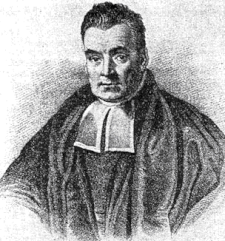Thomas Bayes
| Thomas Bayes | |
|---|---|
 | |
| Narození | 1702 Londýn |
| Úmrtí | 17. dubna 1761 (ve věku 58–59 let) Royal Tunbridge Wells |
| Místo pohřbení | Bunhill Fields Burial Ground |
| Alma mater | Edinburská univerzita |
| Povolání | matematik, statistik, klerik a filozof |
| Ocenění | společník Královské společnosti |
| Nábož. vyznání | presbyterianismus |
| Podpis | |
| Některá data mohou pocházet z datové položky. | |
Thomas Bayes [ˈbeɪz]IPA (1701 (?)[1] – 1761) byl anglický duchovní, dnes známý především pro formulaci tzv. Bayesovy věty, která udává, jak podmíněná pravděpodobnost nějakého jevu souvisí s opačnou podmíněnou pravděpodobností.
Tzv. bayesovská statistika byla využita např. při hledání černých skříněk airbusu Air France, který při letu 447 v červnu 2009 havaroval nad Atlantským oceánem při letu z Jižní Ameriky do Paříže. Uplatnila se také při pátrání po jaderné ponorce USS Scorpion.[2]
Galerie
- Plaketa
- (c) John Bayes, CC BY-SA 2.0Hrob
- Hrob
- Hrob
Reference
- ↑ Bellhouse. The Reverend Thomas Bayes, FRS: A Biography to Celebrate the Tercentenary of His Birth. Statistical Science. 2004, roč. 19, čís. 1, s. 3–43. Dostupné online.
- ↑ Boeing mohou najít i vzorce kněze z 18. století. Minule se osvědčily. iDNES.cz [online]. 2014-03-22. Dostupné online.
Literatura
- Andrew I. Dale. "Most Honourable Remembrance: The Life and Work of Thomas Bayes". ISBN 0-387-00499-8. Springer, 2003.
- Stephen M. Stigler. "Thomas Bayes' Bayesian Inference," Journal of the Royal Statistical Society, Series A, 145:250–258, 1982.
- Stephen M. Stigler. "Who Discovered Bayes's Theorem?" The American Statistician, 37(4):290–296, 1983.
- Michael Kanellos. "18th-century theory is new force in computing" CNET News, 18 Feb 2003.
- Thomas Bayes, "An essay towards solving a Problem in the Doctrine of Chances." Bayes's essay in the original notation.
- Thomas Bayes, 1763, "A letter to John Canton," Phil. Trans. Royal Society London 53: 269–71.
- D. R. Bellhouse, "On Some Recently Discovered Manuscripts of Thomas Bayes."
- Dale, A.I., 2005, "An essay towards solving a problem in the doctrine of chances" in Grattan-Guinness, I., ed., Landmark Writings in Western Mathematics. Elsevier: 199–207.
Externí odkazy
 Obrázky, zvuky či videa k tématu Thomas Bayes na Wikimedia Commons
Obrázky, zvuky či videa k tématu Thomas Bayes na Wikimedia Commons - Who was The Rev. Thomas Bayes? (en)
- Biographical sketch of Thomas Bayes (en)
- An Intuitive Explanation of Bayesian Reasoning (en)
- The will of Thomas Bayes 1761 (en) Archivováno 3. 2. 2011 na Wayback Machine.
Média použitá na této stránce
Portrait of an unknown 19th-century Presbyterian clergyman.
Identified as Thomas Bayes (d. 1761) in Terence O'Donnell, History of Life Insurance in Its Formative Years (Chicago: American Conservation Co:, 1936), p. 335 (caption "Rev. T. Bayes: Improver of the Columnar Method developed by Barrett.")
Again reprinted in Stephen M. Stigler, Springer Statistics Calendar 1981 (Springer-Verlag, New York, 1980).
A challenge "Who Is this gentleman? When and where was he born?" was published in IMS Bulletin, Vol. 17, No. 1, January/February 1988, page 49. The results were published in IMS Bulletin, Vol. 17 (1988), No. 3, pp. 276–278.[1]
David R. Bellhouse of University of Western Ontario in a reply argued that the man depicted being Thomas Bayes is unlikely, as
- "The first thing to note in this picture is the apparent absence of a wig, or if a wig is present, it is definitely the wrong style for the period. [...] The second thing to note is that Bayes appears to be wearing a clerical gown like his father or a larger frock coat with a high collar [...] the gown is not in style for Bayes's generation and the frock coat with a large collar is definitely anachronistic. [...] For reference, I have used C. Willett Cunnington and P. Cunnington, Handbook of English Costume in the Eighteenth Century, pub. Faber & Faber, London, 1964."
Bellhouse compared pictures of other nonconformist ministers, that of Thomas Bayes' father Joshua Bayes (d. 1746), and that of Richard Price (1776).
Compare File:Philip Doddridge.jpg for the portrait of a nonconformist minister of Thomas Bayes' generation (dated 1751).
Stephen M. Stigler of University of Chicago, USA, wrote that it is possible that O'Donnell (1936) "got the picture from some (perhaps 19th century) source where it was identified as Bayes. The question would then be: 'What is that source, and what was that source’s source?' So little is said of Bayes in O’Donnell’s book that it is extremely implausible that he would choose him (and Thomas Simpson, who is also depicted in a similar style) as the subject for an invented picture."Autor: Simon Harriyott, Licence: CC BY 2.0
Thomas Bayes 1702 - 1761 Nonconformist minister and mathematician Originator of the statistical theory of probability, the basis of most market research and opinion poll techniques, lived here 1731-1761 Fourth centenary
(c) John Bayes, CC BY-SA 2.0
Bayes-Cotton Tomb at Bunhill Fields The Burial Ground at Bunhill Fields contains the graves of William Blake, Daniel Defoe, etc as well as this tomb. The Rev. Thomas Bayes (c.1701-1761)is one of those entombed in the vault. His work triggered what is now known as Bayesian Probability.
Autor: Cory Doctorow, Licence: CC BY-SA 2.0
Tomb of statistician Thomas Bayes, Bunhill Cemetery, London
Autor: Cory Doctorow, Licence: CC BY-SA 2.0
Tomb of Thomas Bayes, Bunhill Cemetery, London, UK









